
Canal Hamamatsu | Top Page > Disaster Prevention > If an earthquake occurrs suddenly...
ここから本文です。
更新日:2022年7月19日
If an earthquake occurrs suddenly...
If you are at home...
1. (0 - 3 sec.) Oh! Earthquake!
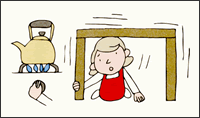
- Severe tremors last for 1 ~ 2 minutes - do not panic and rush outside!
- First and foremost, get under something like a desk and protect yourself - this is vital.
- If you were using a flame then turn it off immediately. But if you feel that you would be in danger doing so, then do not endanger yourself - just leave it be.
- Open the front door and secure exit routes.
2.(1 - 2 min.) The tremors have stopped.
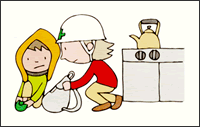
- If a fire has broken out then calmly try and extinguish it in its early stages.
- Confirm that your family is safe.
- Check that the origins of the fire are now safe.
- As there will be many dangerous items on the ground even indoors, wear shoes or slippers.
- Protect your head, as there will be aftershocks. Wear a safety hood and helmet. If these aren't available then wrap your head in a towel.
- Prepare the emergency items that you will take when you evacuate.
- Evacuate immediately if you are in an area expected to experience landslides or tsunamis.
3.(3 min.) Is everyone safe?
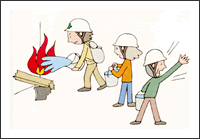
- Right after your family's safety comes your neighbors' safety- if a fire has broken out nearby then alert everyone in a loud voice. Using fire extinguishers and bucket relays, put out the fires together.
- Always be careful, not forgetting about aftershocks.
- Do not enter or approach houses that are leaning. Be careful of cracks appearing in slopes.
- If you have slight injuries, treat them at home.
4.(5 min.) Turn on the radio
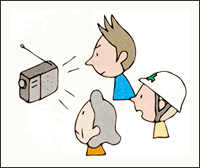
- Turn on the radio and check for correct information. Make sure that you are not confused by unfounded rumors.
- Keep telephone use to a minimum. Dial 171 - the Disaster Emergency Message - to leave and access safety information
- Do not evacuate by a vehicle as emergency vehicles will prioritize roads.
5.(5 - 10 min.) Go to school and collect your child.
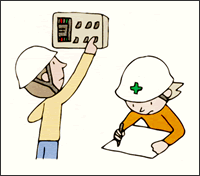
- Close gas valves and switch off the breaker switch.
- When you leave your house, leave a note or sign so that people know that your family is safe and your destination.
- Collect your child as per the pre-determined family plan and at the pre-determined location.
- Take ample precaution as there may be falling glass or signs, or leaning concrete walls or vending machines that topple over.
6.(10 min.- several hours) Help with fire-fighting and rescue efforts!
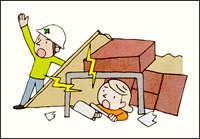
- Work with the people in your area to combat fires and rescue those in need. If you come across a difficult situation alert the fire brigade.
- If you find yourself trapped in a collapsed building, then let people know where you are by making noise by shouting or banging pans.
- Carry out simple first aid by yourself.
7. (- 3 days) Help each other and be patient!
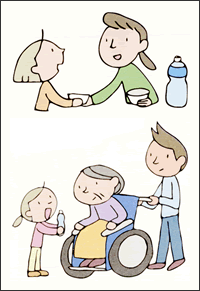
- You cannot expect material aid for a few days. For a while you will have to put up with just the water and food you brought in your emergency pack. Try your best to help one another.
- Watch out for announcements and information from the City.
- Entering damaged houses is extremely dangerous, so be sensible at all times.
The 3 Rules of Life at an Evacuation Center
1.Independent Disaster Prevention Groups are the focal point.
2.Obey rules.
3.Help each other.
Evacuation Areas are communal living areas. Time spent there should be full of cooperation and a spirit of mutual aid, and rules should always be obeyed. Treat those who are disabled or injured with warmth and kindness.
If you are out and about...
1.If you are walking alongside a road...
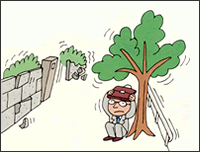
- Protect your head using your hands or your bag and flee to safety, either under roadside trees or inside a sturdy-looking building. Do not at any time face your palms upwards as there is a danger of blood vessels in your wrists being slit. When you enter a building keep your body pressed up against a wall.
- Keep distance from concrete walls, gate pillars and construction sites.
- Narrow roads are dangerous, so flee to as wide a space as possible.
2.If you are in a supermarket or department store...
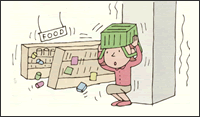
- Distance yourself from shelves.
- If there are baskets close by, use them to protect your head while waiting for the tremors to stop, keeping your body close to a wall or large pillar.
- Calmly follow the orders of staff or in-store announcements. Do not panic and head for stairs or escalators.
3.If you are inside an elevator...
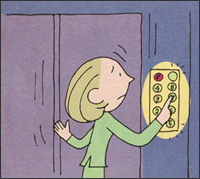
- If you feel the tremors of an earthquake, press the buttons of every floor and get off the next time it stops.
- If the doors do not open due to power cuts or other reasons, then press the emergency contact button and wait for instructions.
4.If you are inside a cinema or theatre...

- Flip the seat up and crouch down on the spot protecting your head with something like a bag.
- Watch your surroundings and follow the instructions of the staff.
- You must not panic and rush to the exits.
5.If you are in a stadium...
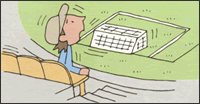
- Wait and watch until the tremors stop.
- Follow stadium announcements and the instructions of staff.
- You must not panic and rush to the exits.
- Fleeing to the center of the field may be safer.
6.If you are in a station or on the platform...
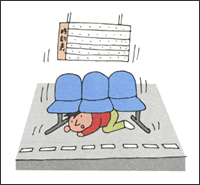
- Protecting your head with your bag, either press up against the nearest pillar or take refuge under a bench.
- Take care not to fall off of the platform.
- Be careful on platforms, as there is a chance that overhead lights and timetables may fall.
7.If you are in a high-rise building...
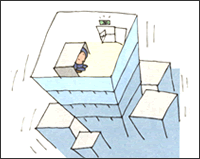
- Upper floors may experience greater shaking than ground level, but these are safe buildings and there is almost no danger of them collapsing or toppling.
- Fire is a serious threat, so be aware of the location of emergency exits in advance.
8.If you are driving a vehicle...
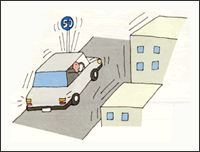
- Do not brake suddenly. This is because cars will spin and roll sideways. Gradually reduce your speed before applying the hazard lights and parking on the left-hand side of the road.
- Turn on the car radio and listen for announcements.
- If it is necessary to evacuate then park your car on the left-hand side of the road and leave the key in the ignition.
9.If you are at the shore or by the mouth of a river...
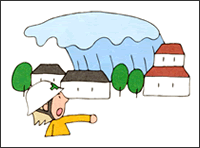
- There is an immediate danger of tsunamis. As soon as the tremors have stopped, evacuate to the upper floors of a nearby building or to higher ground. Do not evacuate by car.
- If there is no higher ground, do your best to get as far as possible away from the sea.
10.If you are in a bus or train...
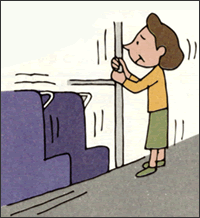
- Grip a railing or an overhead strap tightly with both hands.
- On railways there is tremor detection equipment. Therefore if a certain type of tremor is felt, then brakes will automatically be applied and the train will come to a halt. Even when stopped though, do not try to exit the train by pulling the emergency latch or by climbing out of the windows.
- Behave calmly, following the instructions of onboard staff.
11.If you are underground...
- On the whole, being underground will be safer than being above ground. Even if there is a power cut, emergency lights will turn on so try to remain calm. The biggest danger comes from panicking.
- Even when pitch black, if you move keeping to the walls, you will eventually arrive at an exit. Until the tremors subside, keep down and protect your head. Flee when the tremors have stopped.
12.If you are riding the subway...
- Being underground is safe. The subway will stop if tremors of a magnitude greater than five are experienced and disaster prevention measures are in effect so remain calm. The biggest danger comes from panicking. Follow the instructions of staff. Do not pull on emergency latches unless instructed to do so.
If you are asleep...
1. (0 - 3 sec.) Oh! Earthquake!
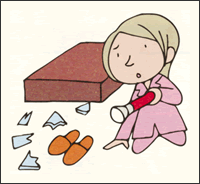
- Using your blankets and futon huddle into a ball and wait for the tremors to subside.
- Distance yourself as much as possible from furniture such as wardrobes.
2.(1 - 2 min) The tremors have subsided.
- Call out to your family to make sure everyone is safe.
- There will be a power cut so the room will be pitch black. Survey the surroundings with a torch.
★Have a torch by your pillow in preparation. - As there will be glass and other objects on the floor, put on slippers or other footwear.
★Have shoes or slippers by your pillow in preparation. - There will be aftershocks so protect your head with a safety hood and helmet, or if these are not at hand, wrap your head with a towel.
- If a fire breaks out, try to extinguish it in its early stages.
- Prepare your emergency items to be brought with you.
- If in an area were landslides or tsunamis are expected then evacuate immediately.
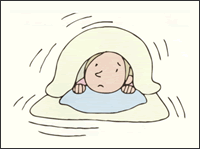
3. (3 min. -) The things that should be here will not be and the things that shouldn’t be here will be! Act with the utmost caution
- There is a power cut and it is pitch black both in - and outside. Furthermore, the floor is littered with debris. Outside there may be cracks on the roads and bridges may have collapsed. Bear in mind that this is a situation that you have never experienced before and you must act with the utmost caution, always checking your surroundings using a torch.
(Guidelines following this are the same as those in the daytime)
If you are near a cliff or the coast...
Coast & River Mouth - Flee from Tidal Waves!
It is anticipated that five minutes after the Tokai Earthquake has struck, the first tidal wave will strike the Suruga Bay and Enshu Coast. Following this a second one will strike then a third, and then continuing tidal waves. When the earthquake strikes, those people on the coast or in areas that are expected to flood should immediately retreat to higher ground or a designated evacuation area.
Points for Fleeing Tidal Waves in the Event of a Sudden Earthquake
- Think of your own safety first and foremost.
- Evacuation is a two-stage process - first to any sort of higher ground and then to an even higher and safer location.
- Do not flee by car.
- Give up on the idea of protecting or carrying household items or your own boat.
- When flooding by tidal waves has started, forget about reaching a far place, and take refuge on the upper floors of nearby buildings.
- Distance yourself as much as possible from hard areas such as rocky areas and banks.
- When you have no choice but to flee inside a building, choose a building that does not directly face the seafront, but is behind a few other buildings that do.
Estimated Tsunami Flood Area
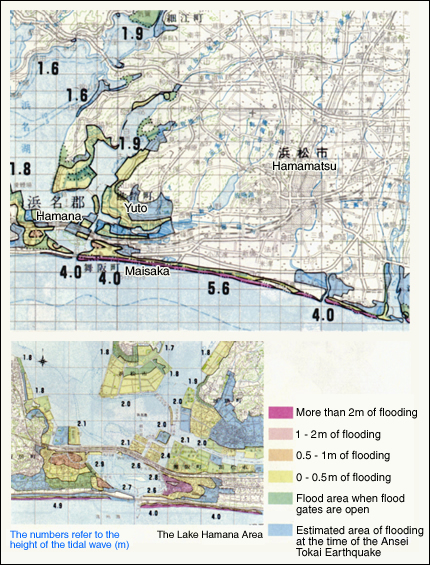
Near Cliffs - Flee from landslides!
If you are near steep inclines such as mountains or cliff faces, there is a danger of landslides. Immediately distance yourself from these areas.
より良いウェブサイトにするためにみなさまのご意見をお聞かせください